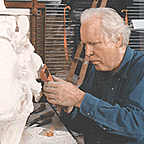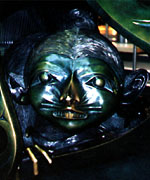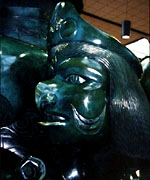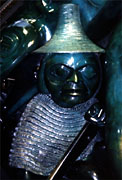| IN MEMORIAM: | (1920-1998) |
Biographical Notes
Upbringing and apprenticeship | Early work | Monumental works
Words and pictures | Bill Reid, 1920-1998 | His legacy
His legacy
"He never lost his sense of being a servant of a great tradition."
David Silcox, "Lives Lived: William Ronald Reid," Toronto Globe and Mail, 26 March 1998"I think it's a shame if people feel they have to re-invent the wheel every time. If you start from scratch you don't get very far. It takes a couple of weeks to make most things, and two or three generations to develop the skills. The trouble I have from young native carvers is that they don't have that tradition and don't want to learn from their elders."
Bill Reid, quoted in Edith Iglauer, "The Myth Maker," Saturday Night, vol.27, no.2 (February 1982), p.18
 Whatever the medium or scale, Reid's chief satisfaction was in "the well-made object" -- in terms both of careful and skilled craftsmanship and of respect for an established formal style (which nonetheless provides some scope for individuality of artistic expression). This concept is evident in Haida art from its earliest surviving manifestations. Reid saw it as fundamental to all worthy human works and thus the link between artists of the present and their ancestors. He much preferred to think of himself as a craftsman rather than an artist. However, the vitality of his creations lies not merely in deep understanding of the conventions underlying Haida art, technical virtuosity and a perfectionist attention to detail, but also his ability to transcend stylistic rules and create something that is at once rooted in tradition yet new.
Whatever the medium or scale, Reid's chief satisfaction was in "the well-made object" -- in terms both of careful and skilled craftsmanship and of respect for an established formal style (which nonetheless provides some scope for individuality of artistic expression). This concept is evident in Haida art from its earliest surviving manifestations. Reid saw it as fundamental to all worthy human works and thus the link between artists of the present and their ancestors. He much preferred to think of himself as a craftsman rather than an artist. However, the vitality of his creations lies not merely in deep understanding of the conventions underlying Haida art, technical virtuosity and a perfectionist attention to detail, but also his ability to transcend stylistic rules and create something that is at once rooted in tradition yet new.
Although in his early years of fame he seemed amused by or uncomfortable with "the Indian thing", he gradually came to accept that it represented the search for his personal cultural roots, even though he was not himself an Indian in terms of his legal status nor of his social upbringing. Not only through his work, but also when speaking publicly or writing for publication, he became an advocate for the respect and recognition deserved by the social and cultural achievements of his ancestors, as well as a critic of the deculturalizing processes to which the Haida had been submitted after the arrival of the white man. In particular he supported the efforts to protect the rain-forest of South Moresby; his presence at the protesters' barricades encouraged the opponents of logging and helped lead to successful resistance. Yet he avoided both recrimination and a romantic desire to turn back time; his stance was instead humanitarian: a hope that Native and non-Native might still work together to build a better future.
 |
 |
| Mouse Woman (left) and Dogfish Woman (right) from The Spirit of Haida Gwaii photo: George MacDonald |
|
One of the ways in which Reid tried to contribute to that future was in providing opportunities for young Haida to rediscover their roots, as he had done. His example has influenced and inspired Native artists of the generation following his. Although he always tended to play down his role as a teacher, many of today's leading Haida artists acknowledge their debt in being associated with him on one project or another. Master-carvers Robert Davidson and Jim Hart, both descendants of Charles Edenshaw, are among Reid's most famous apprentices, although he preferred to think of them as protegés. Above all he sought to show, by example, the importance of aspiring to high standards, themselves based on an understanding of traditional art.
Although his work fetches very high prices in the art market, fortunately many of his key works have either been installed in public places, or are publicly accessible in the collections of museums, most notably the UBC Museum of Anthropology (the largest collection of his works), the Vancouver Art Gallery (where his first one-man show was held in 1974), and the Canadian Museum of Civilization (the single largest gathering of the monumental works from his later period).
 The Ancient Reluctant Conscript from The Spirit of Haida Gwaii
The Ancient Reluctant Conscript from The Spirit of Haida Gwaii
-- a self-portrait?
photo: George MacDonald
Although Bill Reid's work was grounded in Haida traditional art, he infused that tradition with modern ideas and forms of expression, and with an individuality that must make us acknowledge his importance first as an artist, and only second as a Haida artist. Nonetheless, artistic revival has played an important part in rebuilding cultural self-confidence and hope for the future in the First Peoples of the Northwest Coast. Part of Bill Reid's achievement -- and one with which he would be well satisfied -- was his pivotal role in that process.
 |
 |